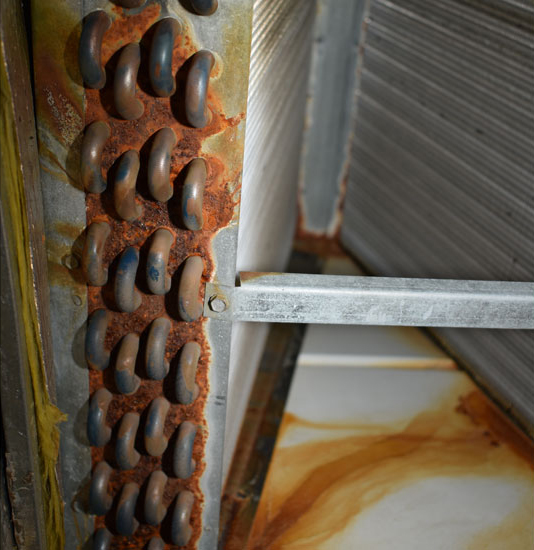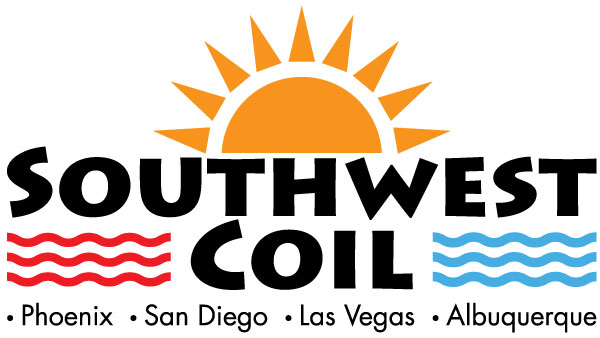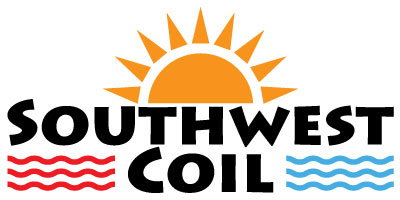Understand and Protect Coils from Salt Corrosion

A salt laden atmosphere can cause enormous damage to any heat exchanger coil over time. That time frame can be variable based on the severity of the atmosphere and the construction of the coil. There are many people who love to live/work by the ocean, but salt corrosion is a real negative that must be dealt with, as it can destroy some of your investment.
What is salt corrosion?
Salt corrosion has 2 other identifiable names – galvanic corrosion and electrolytic corrosion. If you use any of the 3 terms (salt, galvanic or electrolytic), you are technically correct. Salt in the atmosphere, along with water (humidity) can cause problems if copper, aluminum, and galvanized steel are touching each other. Where does this happen – in almost any coil fabricated today.
Metals are either cathode (negative) or anode (positive) and react to each other when a corrosive agent is present. In the case of copper, it’s in the middle of the scale and will be the last material that will start to show deterioration. Galvanized steel (a zinc coating on steel) and aluminum are near the bottom of the scale and will begin to deteriorate quickly in a moist salt atmosphere.
Where is salt corrosion?
Salt corrosion occurs whenever salt water is in proximity to coils. The term “proximity” is where the variable distance comes into play. Most people think that salt corrosion happens within a few miles of the beach – that’s not always true! There may be back bays that have enough salt content to cause corrosion many miles from the beach. It also has a lot to do with prevailing winds and how far those winds can blow onshore. The worst salt corrosion normally happens at night and into the early morning hours, because that’s when air has its highest moisture content.
In some areas of the country, we’ve seen salt corrosion 50 miles from beaches. Two of those areas are, 1) the Bay Area in California and 2) inland Florida; i.e., Orlando or Lakeland. It may take longer to occur, but there’s no doubt that it’s salt corrosion.
What types of coils corrode?
The most prevalent type of coils susceptible to salt corrosion are air-cooled condenser coils, because they are almost always outside and using fresh air for their performance. Next are evaporator coils – especially in packaged ground and roof air conditioners. These coils have problems if there is any fresh air entry during an economizer cycle. Chilled water coils can also have salt corrosion – especially if any percentage of outside air is used for their performance.
What does salt corrosion look like?
Salt corrosion starts out with a very white tint in and around tubes in a coil. Sometimes you need a flashlight to see the vague difference between the aluminum further away from the tube versus right near the tube. That’s the beginning of electrolytic corrosion and is the aluminum deteriorating where it touches the copper.
Remember: Coils have aluminum fins with collars. That’s why you can’t see the copper in the face of a coil. When moist salt gets into this very tight area, the aluminum gives way to the copper. It isn’t only happening on the first row of tubes that can be viewed but all the rows of tubes through the inner core of the coil. If the galvanized steel is corroding, there will be rust and crud at or near where the copper tube passes through the galvanized tube sheets and intermediate tube sheets.
What are the performance ramifications?
Coils are heat transfer equipment and are totally dependent on airflow and fluid flow to achieve capacity. Salt corrosion can destroy heat transfer in basically 3 ways – 1) When aluminum is being eaten away from touching the copper tube, the coil loses secondary heat transfer. The fluid inside the tubes can’t transfer its energy as efficiently since the primary surface (tubes) and secondary surface (fins) are not touching. 2) The buildup of a white chalky material further insulates the fin from the tube and destroys even more heat transfer. 3) This buildup of foreign material also creates a higher air resistance, and the coil efficient goes down due to less airflow.
How can I protect a coil from salt damage?
There are two ways:
- Do not have dissimilar metals in contact with each other. Use copper fins in lieu of aluminum fins and use 304 Stainless Steel on casings and frames in lieu of galvanized steel. The added cost is about 2 1/2 times the cost of the normal coil construction but is well worth the added expense when you consider longevity.
- Use baked and dipped epoxy coating that’s also electrically charged to the surfaces. This normally adds 30% to 50% to the price of the normal coil construction. A very important note – do not use any spray on coatings, because they don’t cover the area of the coil tube to fin bond that is required to stop salt corrosion. Spray coatings are on the market because they are cheaper. They may look nice, but they are virtually useless and the proverbial “waste of money”.
Southwest Coil exclusively represents USA Coil & Air in the Southwest Region and has 5+ decades of manufacturing knowledge and technical experience to assist you with salt laden atmospheres. We have built many of the coils in question. Most of the time, we only need the make and model number to decipher the coils required. Remember: We can change microchannel coils to a heavier duty version or change them to an equivalent finned tube design.
Contact the experts at Southwest Coil for all your coils needs!
We’re the best in the business – take advantage of
our knowledge and experience.


